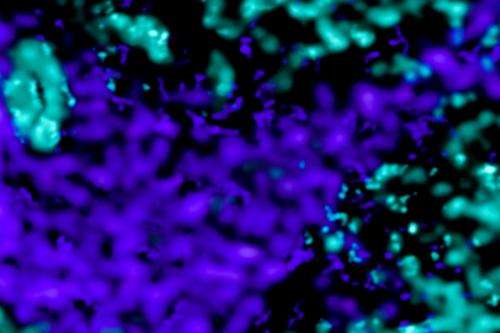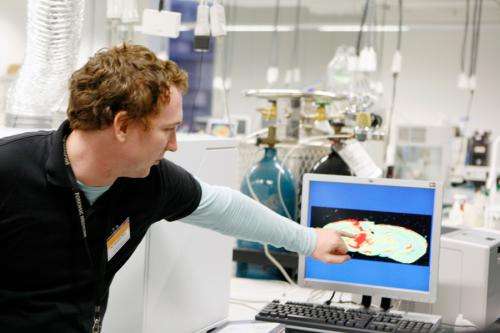Recreation of dopamine (purple) and iron (teal) distribution in the mouse midbrain. Credit: Ethix Design
(Medical Xpress)—A breakthrough investigation by UTS researchers into the underlying causes of Parkinson's disease has brought us a step closer to understanding how to manage the condition.
The team, led by UTS postdoctoral fellow Dr Dominic Hare and Professor Philip Doble, has produced the first empirical evidence that an imbalance of iron and dopamine in the substantia nigra pars compacta (SNc) region of the brain is the root cause of the neurodegenerative condition.
Caused by the slow loss of neurons in the SNc that control autonomous movement, Parkinson's disease causes persistent shaking, gastrointestinal problems and a variety of other ailments.
More than 80,000 Australians suffer from the illness, most over the age of 60.
Hare's findings, before only assumptions in the scientific community, finally validate the theory that iron and dopamine react to create free radicals in the brain that slowly destroy neuron pathways and bring about the onset of Parkinson's.
"When these two chemicals react, it forms a toxic species of dopamine that essentially reacts like bleach in the brain," said Hare.
To conduct their research Hare and his team used a unique tagging technique using antibodies labelled with gold nanoparticles that acted as proxies for dopamine molecules. This enabled the team to monitor and "co-localise" metals with other molecules and proteins in the brain.
And the findings of this work, said Hare, were revelatory.
Dominic Hare. Credit: Carmen Lee Spiers
"What we found is those particular cells (in the SNc) have what you could call an 'anti-Goldilocks effect' – they have just the right amount of iron and just the right amount of dopamine to cause damage," said Dr Hare.
"When we give mice a toxin that mimics the effects of Parkinson's disease, these cells degenerate."
Hare theorises that this effect is likely a natural result of aging, when the brain's ability to securely store iron diminishes and allows iron molecules to "leak" into critical areas such as the SNc.
Finding ways to design drugs that can get into the brain and eliminate surplus iron – an initiative that is already well underway in the process of treating other illnesses like cancer and Alzheimer's disease – is now the next step forward in research.
Preventative measures to halt the build-up of iron in the brain as humans undergo the aging process are also touted by Hare as an important next step, and is something he is now working on.
"I think the real hope is, while we might not necessarily find a cure, prevention is actually not that far away," said Hare.
"So it's a case where you can wake up and say, 'my Parkinson's is flaring up again', take a tablet and go about your business."
More information: "An iron–dopamine index predicts risk of parkinsonian neurodegeneration in the substantia nigra pars compacta." Dominic J. Hare, et al. Chem. Sci., 2014, Advance Article, DOI: 10.1039/C3SC53461H
Provided by University of Technology, Sydney





















